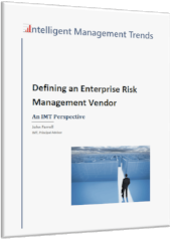For this longtime advocate of dynamic scenario planning, it is encouraging to see resistance waning for integrating deeper risk analysis with strategic planning processes.

Business executives historically have avoided multiple scenarios and frequent strategy reviews as if they were the latest flu strain. They expect economists, industry analysts, and business strategists to produce a single outlook...and then proceed to pass judgment on the accuracy of these static views in hindsight.
Human nature is predisposed to ignore or even reject consideration of uncertainties and course corrections. Yet increasing complexity, volume, and velocity of risks for global market operations set the real context for management decision making in pursuit of strategic objectives.
Despite this growing market complexity and higher expectations for managing risks, most enterprises still conduct strategy planning using a single annual market outlook. In times of clear economic or financial risks, planning sessions may add a “downside” potential and quarterly reviews. Use of an upside scenario is even rarer.
The preferred solitary perspective of a business outlook may facilitate consideration of individual risk factors and potential events with ceteris paribus assumptions, but it stifles the managerial flexibility needed to prepare for the realities of the perpetual interconnected dynamics of actual business conditions.
Why the Resistance to Decision Analytics?
Some of the basic elements of management decision making include
- a set of empowered decision makers,
- an informed assessment of alternative decisions, and
- clear organizational objectives that drive decision rules.
Leaving aside the actions taken after making a decision, a successful ROD (Return on a Decision) is dependent on the analytical thoroughness, cost, and speed of the decision process. In this context, management resistance to a disciplined analytical decision-making process typically falls into one of these four perception (or more accurately misperception) categories:
- The process will be too slow
- The costs will be too high
- “Thorough analysis” relies on models that cannot be trusted
- Business leaders will appear indecisive
The first two objections are weakening over time with technology advances that support speedier and more efficient decision-making processes. The third challenge raises valid concerns that should always be part of a healthy decision process, with analytical confidence levels in predictive models a factor for consideration but not worthy of a roadblock. The fourth objection, however, is a challenging cultural hurdle.
Thinking in shades of potential conditions and outcomes is unnatural. Good business leaders are supposed to be decisive and set a successful course of action. We judge them by their individual foresight, their drive toward that vision, and their command of a rallying action plan. Deference to a decision-making process and a decision-making team may project weakness.
Consider the challenges of an entrepreneur seeking funding. Introducing multiple scenarios is a sure way to have a ten-minute funding pitch cut short.
Fortunately, there are hopeful signs that current management concepts are adopting more dynamic planning, scenario analysis, and risk-iformed decision-making processes to address risk events and business opportunities as they arise.
Hopeful Management Trends Embedding Risk Management Principles
For all you risk managers and scenario planning advocates, take heart in the latest business management trends. Corporate boards acknowledge advancing enterprise risk management and cultivating a risk culture are organizational priorities. This KPMG/EIU study verifies C-suite executives perceive risk management as critically important to their success.
We are trending toward better management decision making processes that integrate dynamic business environment factors and alternative risk scenarios. The rise of risk management as a core decision-making discipline is supporting the integration of people, processes, technology, and information resources to help optimize business decisions in the context of specific organizational objectives.
Historically, information technology has enabled the collection and assessment of data to support operational decisions in specific business functions and process flows. Meanwhile, waves of various corporate dashboards have risen and fallen, limited by their ability to fully integrate organizational data and effectively communicate meaningful information to the C-suite and top strategic decision makers in a timely manner.
Now we have a confluence of analytical tools, the ability to manage larger data sets, evolving organizational decision processes, board participation, and risk information data sources which can be better orchestrated across an enterprise using the principles of risk management. A rise in a class of skilled and influential risk managers and consultants are molding broader risk awareness and its application to business decision making across organizations.
Remaining Hurdles for Enterprise Risk Management Implementation
The SEC, ratings agencies, shareholders, regulatory agencies, partners, and customers share rising expectations for companies to prove a sustainable disciplined approach to assessing and managing enterprise risks. Nevertheless, many adoption and maturity challenges remain, including:
- Enterprise risk management is still in an immature, low-visibility adoption phase in most industries outside of financial services.
- Risk management often has a precise entrenched meaning for particular business functions and industries which generates resistance to a broader, consistent enterprise perspective.
- A myriad of confusing and misleading uses of the term risk management among third-party consultants and software providers blurs the purpose and benefits for enterprises.
- Standards organizations struggle with balancing detailed directives for risk management with language flexible enough to adapt to any type of organization.
- Risk assessments and decisions are just beginning to break down the siloed functional and department approach.
- The link with regulatory compliance is a strong driver for adoption and naturally blends with GRC software functionality, but detracts from the potential power of risk management integrated with disciplined decision making (due to the perception of costs and time requirements noted earlier as resistance factors).
- When decision makers equate risk management to absolute quantitative models, the discipline simultaneously suffers from distrust by some and too much trust from others.
- Cultural resistance to empowering a group process over individual insight and instincts lingers.
A Commitment to Advance Risk-Informed Decision Making
Effective decision-making processes should not focus on risk mitigation, but rather risk optimization in pursuit of business objectives. The business concepts used in risk management decision making processes should eventually blend into everyday business decision making.
The adoption of risk management principles will also help convert static enterprise planning and strategic decision making to a dynamic, proactive practice better aligned with the reality of constantly changing business conditions. Trail-blazing enterprise risk managers are making progress, but broader adoption will depend on more communication and education of basic risk concepts, terms, resources, and benefits to overcome cultural and organizational barriers.
Based on many years of analyzing global business consulting and information technology market trends, the IMT research site and our “Ixnay Ceteris Paribus” blog are dedicated to advancing enterprise use of real-time risk analytics and risk management principles to support business decision making. We identify and promote the use of risk management solutions and other consulting, software, and information vendor offerings that help enable efficient risk-aware decision-making processes.
IMT builds its market research services and analysis to connect:
- Trends in business risk dynamics
- The drivers and influencers for implementing risk-informed decision-making processes
- The adoption and maturation of risk management programs in organizations
- Managers implementing and guiding the use of risk management principles
- Risk management consultants offering best practices for organizational and process considerations
- Risk management software providers
- Technology advances that enable broader risk analytics, real-time risk monitoring, and advanced scenario analysis
- Risk information and data analytics sources
Our research, consulting, and advisory resources help facilitate a dialogue among business risk management practitioners and external services and product vendors interested in building a common language and partnerships that will advance risk management discipline at the core of efficient enterprise decision making.
Join us in advancing strategic management processes and operational business decisions that incorporate the realities of operating in highly dynamic market conditions. It is time to ixnay the use of ceteris paribus as a decision-making crutch.








